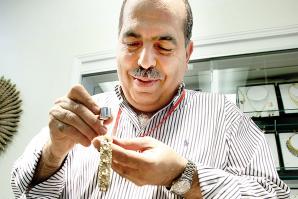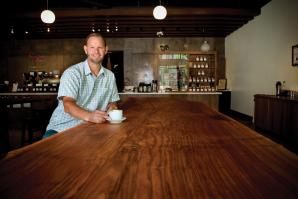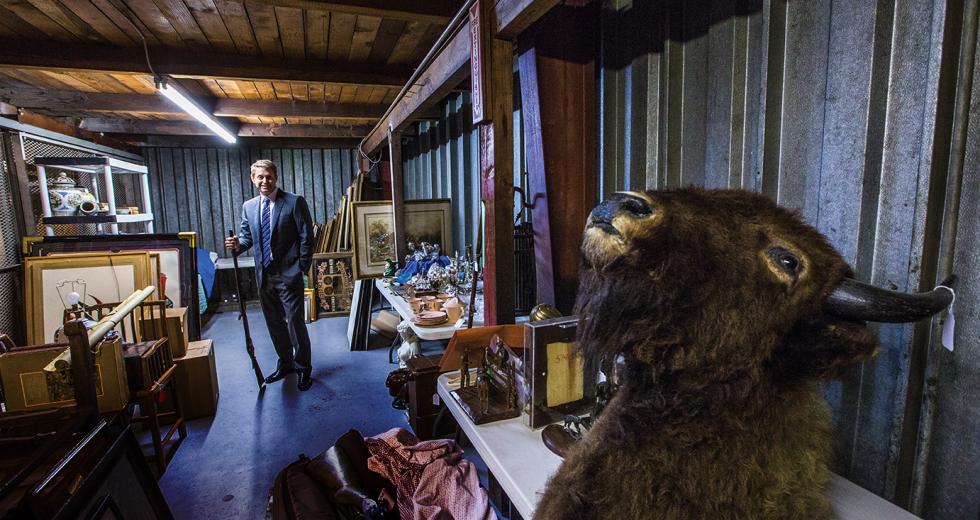Juxtaposed against the crisp, modern lines of Brian Witherell’s home in Alkali Flat sits a trove of ancient treasures, premier antiquities cherry picked from his company’s massive antique collection.
Witherell’s Auction House is a family business, started in 1982 by Brian’s father, Brad, an avid collector of firearms and Western Americana since 1969. And while Brian wasn’t always sure he’d go into the antique business himself, growing up encased in history left a lasting impact.
“I’m not drawn to guns as much as other aspects,” Witherell says. “But I was always in my dad’s office. I remember he had a painting of Custard’s battlefield. It was so detailed, and I would just sit there and study that and get engaged in that particular painting.”
Prior to 2005, Brian and his father dealt primarily in private acquisitions, jet setting around the country to procure collectibles for a Midwestern doctor and an heir to a snap-on tool throne. That was before the economy crashed.
Witherell says that the recession, coupled with an aging collector base that is gradually being replaced with a new generation of tech-savvy hunters, changed his business model, pushing him toward online sales. Now, he sells more than 90 percent of his wares at seasonal online auctions held through iGavel.com. They feature everything from fine art to vintage automobiles.
All those items have to live somewhere. The front lobby of his home, where Witherell takes his meetings, is artfully appointed with a Ming Dynasty-era Huanghuali table (estimated to be worth $60,000 to $80,000) and horseshoe-backed chairs (that run for up to $50,000 apiece). Witherell was in the running against big names like Christie’s to procure the collection, which, along with other Asian antiques, went up for auction in mid-March.
He is an avid collector though, and not everything fits nicely into the Witherell family’s two-story home. Much of what has been sold or is in need of cataloguing sits across the driveway in a small storage building. Witherell moves deftly through what appears to be a scattered maze of discarded miscellany. As he reaches up to shelves or moves aside a box, it becomes clear that this chaos is meticulously organized. He gingerly picks up the weathered face of a tall William Cummens case clock, placing it beside its towering, mahogany body as he weaves his way through the hodgepodge.
“These street lights are fun,” he says, gesturing to a couple of
cast iron lamps (he says, perhaps jokingly, that they must weigh
about 800 pounds) he acquired from the estate of Sacramento’s
late Eppie Johnson, the restaurateur and founder of Eppie’s Great
Race. The lamps, adorned with emblems of California history, like
steer heads and wagon trains, are from San Francisco and date
back to the turn of the 19th century.
It seems impossible that one man’s brain can keep all of these
items — their origins, value, age and story — straight. But
Brian, who moonlights each summer on PBS’s “Antiques Roadshow”
television series, also works in appraisals and has, over the
years, built a massive reference library plus a network of other
antique experts he can call on for second opinions and advice.
He says the fickle market for antiques can leave amateur antique buyers with collections worth far less than they were procured for. There’s no reliable way to predict what buyers will want, and that means what is valuable today may not be en vogue in the coming decades. He compares a Louie Vuitton trunk he pulled from a garage on 17th Street to a powderhorn that predates the revolutionary war. Both sold for $5,000 (almost a third of what the powderhorn is worth, he says).
“A powderhorn is much more rare,” he says. “In terms of historical significance, it’s much more significant. It shows this time and place in America, so it’s really a powerful statement in my mind. A Louie Vuitton trunk just has the monogram, but millions of people want it and therefore it brings in a lot of money.”
He says the market is currently moving away from what he calls “grandma furniture,” pieces that are heavy, ornate and overwrought. In demand are Asian and contemporary styles. Translation: 1980s furniture is now fetching more at an auction than 18th century pieces.
Witherell says there is no crystal ball to predict which way the market will go. Even he has been surprised. Last spring, he was called to an estate in Sonoma County to assess a collection of gold the owner had purchased on QVC.
“She had boxes and boxes, and you would think that would have to be the stupidest investment that you could make,” he says. But the savvy senior had purchased the pieces when gold ran for $400 an ounce. Witherell sold it at $1,800 per ounce.
“She (more than) tripled her money from shopping on QVC,” he laughs.
So there’s money to be made. Locked in a safe in Witherell’s office is an antique, gold quartz chain in pristine condition. It was purchased by a goldsmith at an antique shop near Bodega Bay for about $1,200. Brian points to thin veins of gold running through the marbleized quartz, explaining its rarity and history. He thinks it could potentially sell for more than $15,000.
Still, Witherell does not recommend getting into collecting for the money. Instead, he recommends amateur buyers focus first on what they love and second on what they can afford. He says every collection needs what is known in the business as a “golden spike,” like the gold quartz chain, an item that will legitimize a collection even if its other pieces are of slightly lesser value.
“You’re never going to get respect for collecting something that is mediocre,” he says pointedly. “So if you can’t afford a million-dollar gun, don’t invest in guns because you’ll never be respected as a gun collector. You need to have a masterpiece in your collection to be taken seriously and for that collection to be viable in the marketplace should anything ever happen to you.”
For those wanting to collect but who lack seven figures to
invest, Witherell says antique advertisements and contemporary
ceramics are a good place to start, as is regional art with local
value.
Still, the biggest piece of advice he has to offer is, “Buy what
you enjoy and what you can live with.” For Witherell, who
expertly makes a living off the monetary potential of antiques,
the true joy comes from embracing historical beauty and
connecting to the past.
One of Witherell’s latest acquisitions comes precisely from that line of thinking. In June of 2013, he purchased the Grass Valley Old West Show, a 40-year-old auction that, though it has changed hands over the years and is almost unrecognizable from its original iteration, holds a value for Witherell that goes beyond the estimated $20,000 it could generate for him annually.
It was started in 1982 by three gentlemen who called themselves the Western Americana Association. One of those men was Brian’s father.
A founder of what was originally a gun show, Brad sold his interest when the cost of hosting the show increased with ballroom rental rates. More than 40 years later, it has come full circle.
Brian calls it a destination show that draws niche collectors from around the country, but says the dealers who frequent the show are people he has known since he was a child. He plans to preserve the traditional form and format of the show. The only addition will be a corresponding online auction, from which highlighted items will be previewed at the show itself. The added revenue from online sales will allow him to better promote the show itself.
This attention to the preservation of history, and investment in what is to him personally significant, is reflective of Brian’s overall philosophy on collecting.
“When done correctly [collecting] can enhance your life,” he says. “It keeps your mind active, and it gives you an aesthetic beauty that you can live with every day. If you end up making money at that, more power to you.”
Allison Joy is the digital editor for Comstock’s. Follow her @MsAllisonJoy.
Recommended For You

Golden Opportunity
Are precious metals a sound investment?
All that glitters is gold in a down market, and in the wake of economic collapse and the sinking Euro, the metal is looking more precious than ever to buyers and sellers of all shades.

Money Tree
New Helvetia Hardwoods is homegrown
Tree aficionado Clark Kayler rescues fallen elms, walnuts, sycamores and redwoods — giants that have lined the streets of midtown Sacramento for more than 100 years — and grants them new life in the form of furniture.



